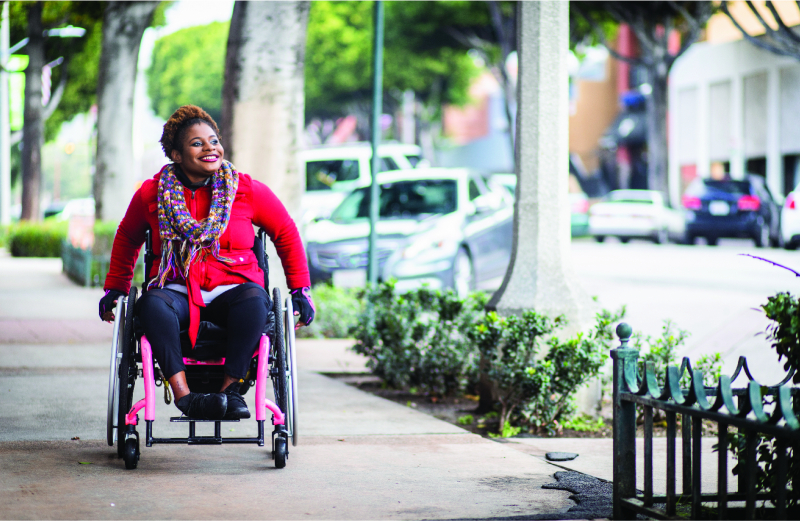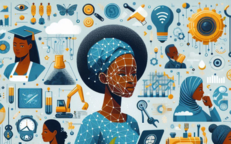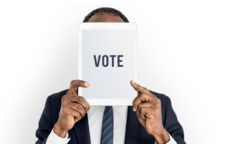Disability Is Not Inability: Addressing The Disability Divide In Africa Using Smart Technologies

This is the 21st post in a blog series to be published in 2021 by the Secretariat on behalf of the AU High-Level Panel on Emerging Technologies (APET) and the Calestous Juma Executive Dialogues (CJED)
The African Union's (AU) Agenda 2063 aspires to develop inclusive strategies for socio-economic growth that comprehensively includes People Living With Disability (PLWDs). The AU Disability Inclusion Guideline[1] and the AU Disability Strategic Framework provide policy directions to strengthen Africa's inclusive and sustainable development by providing strategic guidance for disability mainstreaming on the African continent. This is executed according to African shared values, norms, and standards for disability mainstreaming across the African continent.
Globally, approximately 15% of the world's population is living with disabilities. This is estimated to be approximately 1 billion people in the world. According to the World Health Organisation, PLWDs are the world's biggest minority;[2] this population is increasing as the world's population grows. Furthermore, approximately 400 million PLWDs are found in developing countries; 20% of this population is found in Africa.[3] In countries where the life expectancy is over 70 years, PLWDs spend an average of approximately 8 years, estimated to be about 11.5% of their life span, living with disabilities.
The World Health Organization has reported that nearly 40% of Africa's population consists of PLWDs. Of this number, between 10% and 15% are school-going children.[4] It has been estimated that school enrolment for children with disabilities ranges between 5% and 10% against able children.[5] In addition, approximately 70% - 80% of working-age PLWDs remain unemployed. This is because most PLWDs find it difficult to find lucrative and meaningful employment and job creation opportunities. Consequently, some PLWDs turn into begging as the means to earn their living.
Poverty has been identified as a major cause of disability because poverty-stricken people inhabit and work in unsafe environments. These unsafe conditions include poor sanitation, crowded living conditions, limited access to education, contaminated water sources, and innutritious food and poor facilities. Such living conditions may, for instance, inhibit pregnant women from accessing proper healthcare, nutrition, and facilities required for bearing and raising healthy children. Wars also contribute to disabilities. Notably, explosions can cause severe injuries and impacted people may become deaf, blind, or sometimes lose their limbs. Other causes of disabilities include accidents, illnesses, and dangerous working conditions. Exposure to chemicals such as pesticides and herbicides may also increase endocrine disruptors in the environment, which may negatively impact and interfere with embryonic (foetal) developmental growth. There are also genetic causes, where in some cases, people born with disabilities may genetically inherit disabilities such as down syndrome from their parents.
Unfortunately, PLWDs face unjustifiable discrimination. For example, PLWDs are increasingly excluded from employment opportunities, skills development and training, education, healthcare services, among other key areas of socio-economic development. Their exclusion is not only preventing them from participating fully in society but can also have negative socio-economic implications for African societies, as they are a missed human resource.[6] In most cases, employers remain hesitant to employ PLWDs because such arrangements may require the adaption of their workspaces to accommodate PLWDs. Employers may have to overhaul and undergo costly renovations to enable disability-friendly workplaces.
There are organisations in African countries that are helping PLWDs. We discuss a few. Able Child Africa is working with local partners to help children with disabilities in Kenya, Rwanda, Tanzania, and Uganda. Inclusion International-Africa works across the entire continent to provide opportunities and resources to PLWDs, so they influence their inclusion in leadership and employment spaces.[7] Disability Africa engages the children through playschemes activities to address mental stress such as isolation and negative attitudes. Partnering with local healthcare providers, Disability Africa has provided and promoted medical support and inclusive education to children with disabilities in The Gambia, Zambia, Kenya, and Sierra Leone[8]. The Africa Disability Alliance and Network of African Women with Disabilities advocate for inclusive legislation and policies pertinent to women with disabilities within African governments and the United Nations. On the other hand, the International Council for the Education of People with Visual Impairments helps people with visual impairments access inclusive quality education that possesses infrastructure suitable for PLWDs.
Despite these successes, there is still more to be done to balance the inequalities in the quality of life of Africans living with disabilities. Therefore, the African Union High Level Panel on Innovation and Emerging Technologies (APET) is calling for African countries to consider investing more in assistive emerging technologies that can address challenges affecting PLWDs. Additionally, APET encourages African countries to exploit innovation that enables PLWDs to conveniently contribute their quota to Africa's socio-economic development as abled human resources.
Generally, Africa has experienced considerable growth in the development and utilisation of technologies. However, there has been a considerable lack of developing technologies that can be adapted for assisting PLWDs. For example, digital technologies and applications have been developed in Africa to enable travelling, banking, and education. However, most of these technologies are not inclusive of PLWDs. Some countries may have policy frameworks related to internet accessibility and guidance for creating accessible digital technologies for all people, including PLWDs. However, innovators, designers, and developers of hardware technologies and web software for digital technologies turn to exploit the gaps in existing policies to ignore the needs of people who experience forms of disabilities.[9] Such technologies have substantial negative implications in academia, industry, and access to government services. Consequently, most digital technologies remain inaccessible to some or all users with disabilities.
Adapting these technologies to be inclusive and assist PLWDs is imperative. To support inclusion and effective adaptation, PLWDs must be involved in the conceptualisation of these innovative technologies so their needs can be adequately considered. African governments, agencies, partners, and the private sector are encouraged to consider disability-friendly assistive technologies and accompanying policy frameworks. Governments can ensure increasing availability, accessibility, and affordability to assistive technologies within social, economic, cultural, and educational programmes and entrepreneurship opportunities.[10]
APET considers inclusive empowerment of PLWDs using emerging technologies an important social inclusion strategy for PLWDs. For example, since most African schools and universities are promoting e-learning programmes for their students since the onset of COVID-19, such initiatives should not further exclude disabled students. Inclusive e-learning programmes allow students with disabilities to access studying material and exchange ideas through disabled-friendly presentation interfaces.
As an example of best practice, digital and audio libraries are technologies gaining applications within some African schools and universities. Students with intellectual, hearing, and reading disabilities, as well as impaired sight, dyslexia, and other disabilities, are able to access educational courses via digital and audio libraries enabled by internet-based technologies. South African students at the University of Limpopo have such libraries and facilities known as the Reakgona Disability Centre.[11] Students from this Centre of Excellence can connect from home, read or listen to relevant subject books - and this is done without physically attending university classes or entering library premises.
APET believes that PLWDs have great opportunities in using digital and internet-based technologies. Thus, African governments are encouraged to build inclusive technology and policy capacity to enable PLWDs to efficiently and timely communicate with their counterparts and their environment. Digital technologies help PLWDs gather and understand information and news, inclusively learn through the mainstream educational systems, participate in leisure interests with others, chat on social media, shop online, manage their finances and banking applications, and access government services.[12]
In conclusion, digital technologies are breaking conventional barriers to communication, interaction, and access to information for persons with disabilities. Therefore, adapting and adopting digital technologies and applications will enable PLWDs can enhance access to lifelong education, skills development, as well as meaningful employment and job creation. Finally, to achieve the "no one must be left behind" aspiration of the AU's Agenda 2063, African countries are encouraged to create enabling and inclusive digital policies and infrastructure suitable for the needs and challenges of PLWDs. Most importantly, disability is not inability.
Featured Bloggers – APET Secretariat
Justina Dugbazah
Barbara Glover
Bhekani Mbuli
Chifundo Kungade
[1] https://au.int/en/documents/20200918/au-disability-inclusion-guideline
[2] https://www.who.int/en/news-room/fact-sheets/detail/disability-and-health.
[3] https://www.un.org/development/desa/disabilities/resources/factsheet-on-persons-with-disabilities.html.
[4] https://www.ascleiden.nl/content/webdossiers/disability-africa#:~:text=A%20World%20Health%20Organization%20source,people%20with%20disabilities%20in%20Africa.
[5] https://www.unicef.org/southafrica/media/1336/file/ZAF-Children-with-disabilities-in%20South-Africa-2001-11-situation-analysis.pdf.
[6] https://www.ilo.org/skills/pubs/WCMS_149529/lang--en/index.htm#:~:text=People%20with%20disabilities%20face%20unjustifiable,has%20economic%20implications%20for%20societies.
[7] https://borgenproject.org/disabilities-in-africa/.
[8] https://borgenproject.org/disabilities-in-africa/
[9] https://www.disabled-world.com/disability/accessibility/websitedesign/tech-challenge.php.
[10] https://assets.publishing.service.gov.uk/media/5b43205a40f0b678b369e262/Mobile_tech_and_inclusion_of_persons_with_disability.pdf.
[11] https://www.suninternational.com/meropa/stories/latest-news/meropa-spruces-up-at-reakgona-disability-centre/.
[12] https://www.un.org/esa/socdev/egms/docs/2013/ict/innovation-technology-disability.pdf.


